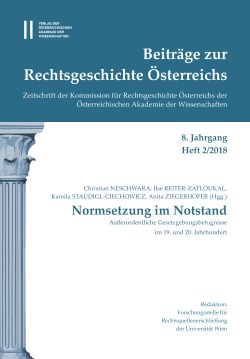
Beiträge zur Rechtsgeschichte Österreichs 2 / 2018, pp. 385-395, 2018/11/28
Normsetzung im Notstand
Außerordentliche Gesetzgebungsbefugnisse im 19. und 20. Jahrhundert
The Austrian constitution of 1920 concentrated all power in the parliament; provisions on a state of emergency were consciously renounced at that time. An amendment from 1929 strengthened the executive branch, introducing a power of the Federal President to issue emergency decrees. In the course of deliberations, however, the Social Democrats succeeded in making the adoption of such regulations subject of the approval of a permanent parliamentary subcommittee. This emergency authority has never been used to this day. However, the instrument of permanent subcommittees was taken up in other contexts in order to ensure parliament’s influence in situations where decisions need to be taken quickly
Keywords: Austrian constitution of 1920–constitutional amendment of 1929–emergency decrees–Federal President–permanent subcommittees